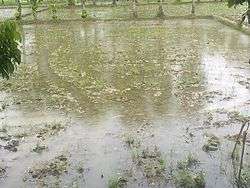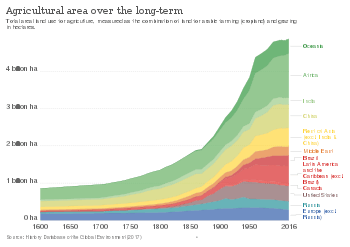Agricultural land
Agricultural land is typically land devoted to agriculture,[2] the systematic and controlled use of other forms of life—particularly the rearing of livestock and production of crops—to produce food for humans.[3][4] It is thus generally synonymous with both farmland or cropland, as well as pasture or rangeland.

The United Nations Food and Agriculture Organization and others following its definitions, however, also use agricultural land or agricultural area as a term of art, where it means the collection of:[5][6]
- "arable land" (a.k.a. cropland): here redefined to refer to land producing crops requiring annual replanting or fallowland or pasture used for such crops within any five-year period
- "permanent cropland": land producing crops which do not require annual replanting
- permanent pastures: natural or artificial grasslands and shrublands able to be used for grazing livestock
This sense of "agricultural land" thus includes a great deal of land not devoted to agricultural use. The land actually under annually-replanted crops in any given year is instead said to constitute "sown land" or "cropped land". "Permanent cropland" includes forested plantations used to harvest coffee, rubber, or fruit but not tree farms or proper forests used for wood or timber. Land able to be used for farming is called "cultivable land". Farmland, meanwhile, is used variously in reference to all agricultural land, to all cultivable land, or just to the newly restricted sense of "arable land". Depending upon its use of artificial irrigation, the FAO's "agricultural land" may be divided into irrigated and non-irrigated land.
In the context of zoning, agricultural land or agriculturally-zoned land refers to plots that are permitted to be used for agricultural activities, without regard to its present use or even suitability. In some areas, agricultural land is protected so that it can be farmed without any threat of development. The Agricultural Land Reserve in British Columbia in Canada, for instance, requires approval from its Agricultural Land Commission before its lands can be removed or subdivided.[7]
Area

Under the FAO's definitions above, agricultural land covers 38.4% of the world's land area as of 2011. Permanent pastures are 68.4% of all agricultural land (26.3% of global land area), arable land (row crops) is 28.4% of all agricultural land (10.9% of global land area), and permanent crops (e.g. vineyards and orchards) are 3.1% (1.2% of global land area).[9][10]
- Total of land used to produce food: 49,116,227 square kilometers or 18,963,881 square miles
- Arable land: 13,963,743 square kilometers or 5,391,431 square miles
- Permanent pastures: 33,585,676 square kilometers or 12,967,502 square miles
- Permanent crops: 1,537,338 square kilometers or 593,570 square miles
Globally, the total amount of permanent pasture according to the FAO has been in decline since 1998,[11], in part due to a decrease of wool production in favor of synthetic fibers (such as polyester) and cotton.[12]
The decrease of permanent pasture, however, does not account for gross conversion (e.g. land extensively cleared for agriculture in some areas, while converted from agriculture to other uses elsewhere) and more detailed analyses have demonstrated this. For example, Lark et al. 2015 found that in the United States cropland increased by 2.98 million acres from 2008-2012 (comprising 7.34 million acres (29,700 km2) converted to agriculture, and 4.36 million acres (17,600 km2) converted from agriculture).[13]
| 2008 | 2009 | 2010 | 2011 | |
|---|---|---|---|---|
| 4,044 | 4,035 | 4,109 | 4,113 | |
| 169 | 169 | 167 | 167 |
Source: Helgi Library,[14] World Bank, FAOSTAT
Russia
The cost of Russian farmland is as little as €1,500-2,000/ha (£1,260-1,680/ha).[15] Farmland can be available in France for roughly €10,000/ha, but this is a bargain; for quality soil, realistic prices vary between €50,000-100,000/ha . Farmland has been seen to be available on the Spanish market for as little as €10,000/ha, but this is non-irrigated land.
The average Russian farm measures 150ha.[15] The most prevalent crops in Russia are wheat, barley, corn, rice, sugar beet, soy beans, sunflower, potatoes and vegetables.[15] The Krasnodar region in Russia has 86,000ha of arable land.[15] Russian farmers harvested roughly 85-90 million tonnes of wheat annually in the years around 2010.[15] Russia exported most to Egypt, Turkey and Iran in 2012; China was a significant export market as well.[15] The average yield from the Krasnodar region was between 4 and 5 tonnes per ha, while the Russian average was only 2t/ha.[15] The Basic Element Group, which is a conglomerate owned by Oleg Deripaska, is one of Russia's leading agricultural producers, and owns or manages 109,000ha of Russian farmland, out of 90m actual and 115m total (0.12% actual).[15]
Ukraine
In 2013, Ukraine was ranked third in corn production and sixth in wheat production.[16] It was the main supplier of corn, wheat, and rape to Europe,[16] although it is unclear whether the internal supply from countries like France were accounted in this calculation. Ukrainian farmers achieve 60% of the output per unit area of their North American competitors.[16] UkrLandFarming PLC produces from 1.6m acres corn wheat barley sugar beet and sunflowers.[16] Until 2014, the chief Ukrainian export terminal was the Crimean port of Sebastopol.[16]
United States
Prime farmland in Illinois is valued, as of August 2018, at $26,000 a hectare.[17]
See also
References
- Lauren Southern (June 25, 2018). "Farmlands: South Africa's Farm Murder Documentary" – via Youtube.
- Oxford English Dictionary, 3rd ed. "agricultural, adj." Oxford University Press (Oxford), 2012.
- Oxford English Dictionary, 3rd ed. "agriculture, n." Oxford University Press (Oxford), 2012.
- See also, e.g., Provincial Agricultural Land Commission. "What is Agricultural Land? Archived August 11, 2014, at the Wayback Machine" The Province of British Columbia. Accessed 1 Aug 2014.
- FAO. FAOSTAT Glossary Archived May 27, 2013, at the Wayback Machine: "Agricultural area".
- OECD. Glossary of Statistical Terms: "Agricultural land".
- Provincial Agricultural Land Commission. Official website. Accessed 1 Aug 2014.
- "Agricultural area over the long-term". Our World in Data. Retrieved 15 February 2020.
- FAOSTAT data on land use, retrieved December 4, 2015
- WDI –World Development Indicators online database, retrieved on July 18, 2008 (may require subscription for access; print edition from the World Bank).
- Poore, Joseph (January 2016). "Call for conservation: Abandoned pasture". Science. 351 (6269): 132. Bibcode:2016Sci...351..132P. doi:10.1126/science.351.6269.132-a. PMID 26744398.
- "Back to the wild: How nature is reclaiming farmland". newscientist.com.
- Lark, Tyler J.; Meghan Salmon, J.; Gibbs, Holly K. (2015). "Cropland expansion outpaces agricultural and biofuel policies in the United States". Environmental Research Letters. 10 (4): 044003. Bibcode:2015ERL....10d4003L. doi:10.1088/1748-9326/10/4/044003.
- "HelgiLibrary - Agricultural Land Area". helgilibrary.com.
- "The future of farming in Russia - Farmers Weekly". fwi.co.uk. 9 December 2013.
- "Ukraine crisis sends grain prices soaring" – via The Globe and Mail.
- Doran, Tom C. (9 September 2018). "Survey finds farmland values down slightly". AgriNews Publications. Archived from the original on 11 September 2018. Retrieved 10 September 2018.
External links
